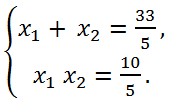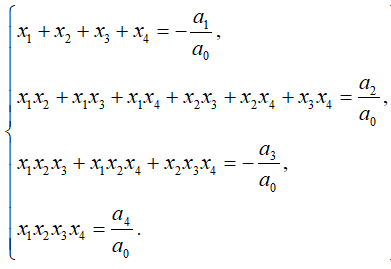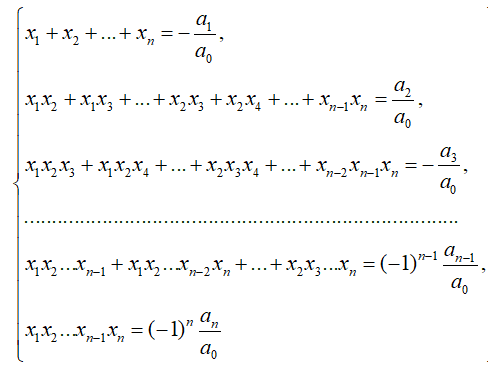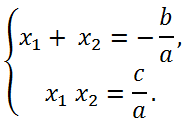Example 1.
Factorize a square trinomial x
2 - 2012x + 2011.
Solution.
It is easy to see that x = 1 is a root of the trinomial. We verify this by a simple substitution. According to Vieta's formula
x
1x
2 =
= 2011 <=> 1*x
2 = 2011 <=> x
2 = 2011. Hence, x
2 - 2012x + 2011 = (x - 1)(x - 2011).
Answer: x
2 - 2012x + 2011 = (x - 1)(x - 2011).
Example 2.
Factorize a square trinomial 2012x
2 + 2011x - 1.
Solution.
A simple substitution easily verifies that x = -1 is a root of a square trinomial. According to Vieta's formula
x
1x
2 =
<=> -1*x
2 =
<=> x
2 =
.
Hence, 2012x
2 + 2011x - 1= 2012(x + 1)(x -
) = (x+1)(2012x-1).
Answer: 2012x
2 + 2011x - 1= 2012(x + 1)(x -
) = (x+1)(2012x-1).
Thus, very often Vieta's formulas allow one to quickly select the whole roots of a square trinomial without performing cumbersome calculations. In addition, one can draw conclusions about the signs of the roots of the equation based on the coefficients of the trinomial. For example, if the roots of the trinomial exist, and
> 0, then either both roots are positive or both are negative.
Example 3.
Determine the signs of the roots of a quadratic equation 5x
2 - 33x + 10 = 0 without solving it.
Solution.
Discriminant of the equation D = b
2 - 4ac = 33
2 - 4*5*10 > 0, therefore, the equation has two real roots. According to Vieta's formulas

That is x
1x
2 > 0, then both roots have the same sign. But the sum of the roots > 0, therefore both roots are positive numbers.
Answer: the equation has two positive roots.
In addition, Vieta's formulas allow you to quickly check whether a given set of numbers are the roots of a polynomial. In general, Vieta's formulas are a very useful tool in solving a wide variety of problems with polynomials.
Let us write out Vieta's formulas for polynomials of the third and fourth orders.
Vieta's formulas for the roots of a third-order polynomial
If x
1, x
2, x
3 - roots of a polynomial a
0*x
3 + a
1*x
2 + a
2*x + a
3, then the following equalities are true for them:

Vieta's formulas for the roots of a fourth-order polynomial
If x
1, x
2, x
3, x
4 - roots of a polynomial a
0*x
4 + a
1*x
3 + a
2*x
2 + a
3*x + a
4, then the following equalities are valid for them:





